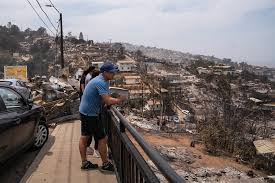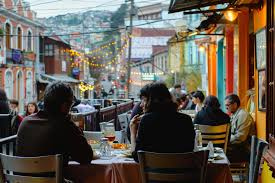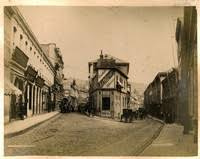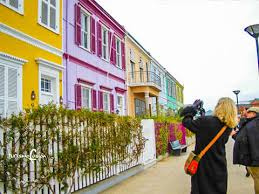What are the most common languages spoken in Valparaíso?

What are the most common languages spoken in Valparaíso?
What are the most common languages spoken in Valparaíso? Languages Spoken in Valparaíso: A Cultural Tapestry.
Valparaíso, a bustling port city in Chile, is renowned for its rich history, vibrant culture, and diverse communities. As a melting pot of different influences, the linguistic landscape of Valparaíso reflects its multifaceted identity.
Understanding the languages spoken in this city can enhance your experience, allowing for deeper connections with its residents.
This guide explores the most common languages spoken in Valparaíso, the historical influences shaping this linguistic diversity, and how you can navigate the city’s cultural fabric.

Spanish: The Dominant Language
The most commonly spoken language in Valparaíso is Spanish, the official language of Chile. As a product of centuries of colonization, Spanish serves as the primary means of communication for the vast majority of the population.
Valparaíso’s Spanish has its unique characteristics, influenced by local dialects, indigenous languages, and the city’s multicultural heritage.
Chilean Spanish, in general, is known for its distinct pronunciation, vocabulary, and slang, which may differ from other Spanish-speaking countries.
As a visitor, learning some basic Spanish phrases can significantly enhance your interactions with locals, making it easier to engage in conversations and connect with the community.
Indigenous Languages
While Spanish dominates, Valparaíso’s linguistic landscape is also enriched by indigenous languages. The Mapuche language, known as Mapudungun, is one of the most notable indigenous languages spoken in Chile.
Historically, the Mapuche people inhabited regions of southern and central Chile, including areas near Valparaíso.
Although the number of fluent speakers has declined over the years, efforts are being made to revitalize and preserve the language and its cultural significance.
In Valparaíso, you may encounter individuals or organizations promoting Mapudungun and cultural events celebrating Mapuche heritage. Engaging with these initiatives can provide valuable insights into the indigenous history of the region.
English: A Growing Presence
Due to Valparaíso’s status as a tourist destination, English has become increasingly common, particularly among younger generations and those involved in the tourism industry.
Many hotels, restaurants, and shops catering to tourists often have staff who speak English, making it easier for visitors to navigate the city.
Additionally, English is taught in schools, and many Chileans are eager to practice their language skills with travelers.
However, while you may find English speakers in tourist areas, it is still beneficial to familiarize yourself with basic Spanish phrases to enrich your experience and connect more authentically with locals.
Portuguese: A Neighboring Influence
Given Chile’s geographical proximity to Brazil, Portuguese is also spoken in Valparaíso, albeit to a lesser extent. The presence of Brazilian tourists and immigrants has introduced Portuguese into the local linguistic landscape.
Many Chileans have also learned Portuguese, especially in the context of tourism and business.
Cultural exchanges and events celebrating Brazilian music, dance, and cuisine can provide opportunities to hear Portuguese in Valparaíso, highlighting the interconnectedness of Latin American cultures.
Engaging with the Brazilian community can be a delightful way to experience the cultural richness of Valparaíso and discover commonalities between the two neighboring countries.
Other Languages Spoken by Immigrant Communities
Valparaíso’s diverse immigrant population has contributed to its linguistic variety. Over the years, various waves of immigrants have settled in the city, bringing their languages and cultures.
You may encounter speakers of Italian, German, and French among local communities, particularly in neighborhoods where these immigrant groups have established roots.
The Italian influence, for example, is evident in local cuisine and cultural traditions.
In addition, recent immigration trends from Venezuela, Colombia, and other Latin American countries have introduced new linguistic elements to the city, with Spanish being the predominant language among these groups.
Understanding Local Dialects and Slang
Chilean Spanish, particularly in Valparaíso, is known for its unique dialects and colloquialisms. Understanding local slang, known as “chilenismos,” can enhance your communication and help you connect with residents.
Examples of popular chilenismos include “po” (a filler word used for emphasis), “cachai” (meaning “do you understand?”), and “bacán” (meaning “cool” or “awesome”).
Familiarizing yourself with these terms can add a fun element to your conversations and demonstrate your interest in the local culture.
As you navigate the city, don’t hesitate to ask locals about phrases or expressions you encounter; they often appreciate the opportunity to share their language and culture.
Valparaíso’s linguistic
Valparaíso’s linguistic landscape is a reflection of its rich cultural tapestry, with Spanish at the forefront and a variety of other languages enriching the community.
Understanding the common languages spoken in Valparaíso can significantly enhance your experience as you interact with residents and immerse yourself in the local culture.
From the vibrant streets of the city to its bustling markets and cultural events, engaging with the diverse linguistic heritage of Valparaíso offers opportunities for connection, understanding, and appreciation.
As you explore this enchanting coastal city, remember that language is a bridge to deeper connections and shared experiences.
Whether you’re practicing your Spanish, learning about indigenous languages, or engaging with the local community, each interaction will contribute to your journey in Valparaíso.
Embrace the linguistic diversity of Valparaíso, and let it guide you toward meaningful encounters and lasting memories in this captivating city.





Leave a Reply